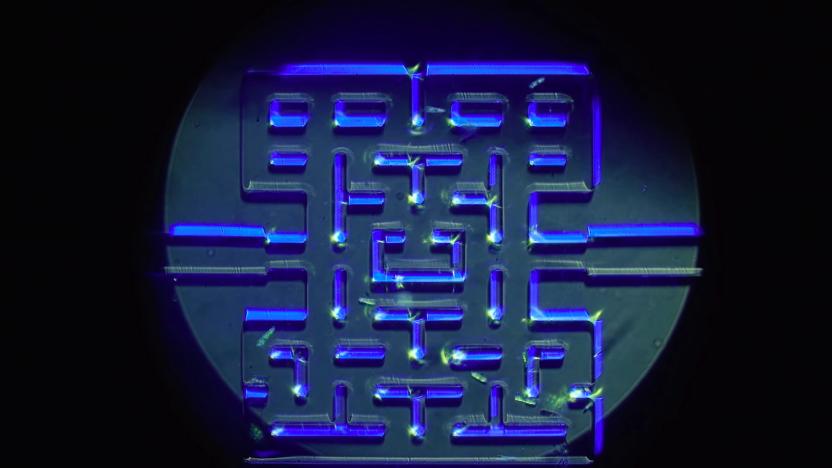nanostructures
Latest

The world's smallest Mona Lisa is made from DNA
Leonardo da Vinci's Mona Lisa painting isn't actually that big (30 inches tall), but Caltech researchers have found a way to make that seem downright gargantuan. They've used DNA to construct the smallest known Mona Lisa. At several hundred nanometers across, they're roughly as large as a lone E. coli bacterium -- the iconic smile is just 100nm wide. The trick was an adaptation of a DNA "origami" method that got the gene strands to fold and assemble into the right shape.

Researchers create a microscopic game of 'Pac-Man'
Researchers with the Institute of Micro and Nano Systems Technology in Norway have built a one-millimeter wide recreation of the original Pac-Man maze, all for the lo-fi enjoyment of some microscopic organisms. Rather than 8-bit graphics and pixelated fruit, the researchers built their "game" out of nanostructures that were colorfully lit in the manner of the 1980 arcade classic and then populated with single-celled organisms representing the circular hero. Rather than ghosts, the bad guys here are hungry multicellular creatures out to eat those unsuspecting ciliates.

Scientists capture images of molecules forming atomic bonds
For most of us, molecular bonding only really exists as a classroom concept. Some scientists at Lawrence Berkeley National Laboratory can now claim more tangible knowledge, however: they're the first to have taken truly clear snapshots of bonding in progress. While trying to create graphene nanostructures and observe them with an atomic force microscope, a lab team spotted molecules forming their individual, atom-level links during a chemical reaction. The resulting shots were nearly textbook material, too -- as the molecules were neatly placed on a flat surface, the researchers identified the order and nature of each bond. While the images will only be immediately useful for the nanostructure research at hand, they may add a welcome dash of reality to future chemistry lessons.

Georgia Tech models swimming, cargo-carrying nanobots
The nanobot war is escalating. Not content to let Penn State's nanospiders win the day, Georgia Tech has answered back with a noticeably less creepy blood-swimming robot model of its own, whose look is more that of a fish than any arachnid this time around. It still uses material changes to exert movement -- here exposing hydrogels to electricity, heat, light or magnetism -- but Georgia Tech's method steers the 10-micron trooper to its destination through far more innocuous-sounding flaps. Researchers' goals are still as benign as ever, with the goal either to deliver drugs or to build minuscule structures piece-by-piece. The catch is that rather important mention of a "model" from earlier: Georgia Tech only has a scientifically viable design to work from and needs someone to build it. Should someone step up, there's a world of potential from schools of tiny swimmers targeting exactly what ails us.

GE turns butterfly-inspired tech into cheap, accurate thermal sensors (video)
When last we heard from GE and its Morpho-butterfly inspired sensors, all the talk was about detecting chemicals. And, with $6.3 million in funding coming from DARPA, we're not surprised. In the latest issue of Nature Photonics, however, the company's researchers show that the wing-like structures are just as good at detecting heat as they are ricin attacks. By coating them with carbon nanotubes the team was able to create a sensor sensitive to temperature changes as small as 0.02 degrees Celsius with a response rate of 1/40 of a second. The sensors could eventually find their way into imaging devices and medical equipment, and are expected to cost just a fraction of similar technologies currently on the market. Of course, since DARPA is still involved with the project, there are some potential security uses as well -- such as screening devices and fire detection. Head after the break for a video and some PR.

Nanoscale ropes braid themselves, tiny sailors still needed to tie tiny knots
While perhaps not being quite as useful as towels, ropes are might handy things to have. With them you can attach things to other things and, well, that's really their primary use. But what if those things are small? Really small. You need nanoropes of the sort created at the Molecular Foundry, braids that measure just 600 nanometers in diameter. A sheet of paper? About 100,000 nanometers thick. Perhaps even more interesting than their scale is how they were constructed, formed of polypeptoids that self-assemble into the coiling double helix you see above. Possible uses? Right now this is a part of experiments to create more complex nanoscale structures, but we could totally see them being used to, you know, tie tiny things together.

3D invisibility cloak fashioned out of metamaterials
Those HDTV manufacturers did tell us that 3D was going to be everywhere this year, didn't they? Keeping up with the times, scientists investigating potential methods for rendering physical objects invisible to the human eye have now moved to the full three-dimensional realm. The Karlsruhe Institute of Technology has developed a photonic metamaterial that can make things disappear when viewed from all angles, advancing from previous light refraction methods that only worked in 2D. It sounds similar to what Berkeley researchers developed not too long ago, and just like Berkeley's findings, this is a method that's still at a very early stage of development and can only cover one micrometer-tall bumps. Theoretically unlimited, the so-called carpet cloak could eventually be expanded to "hide a house," but then who's to say we'll even be living in houses by that time?


